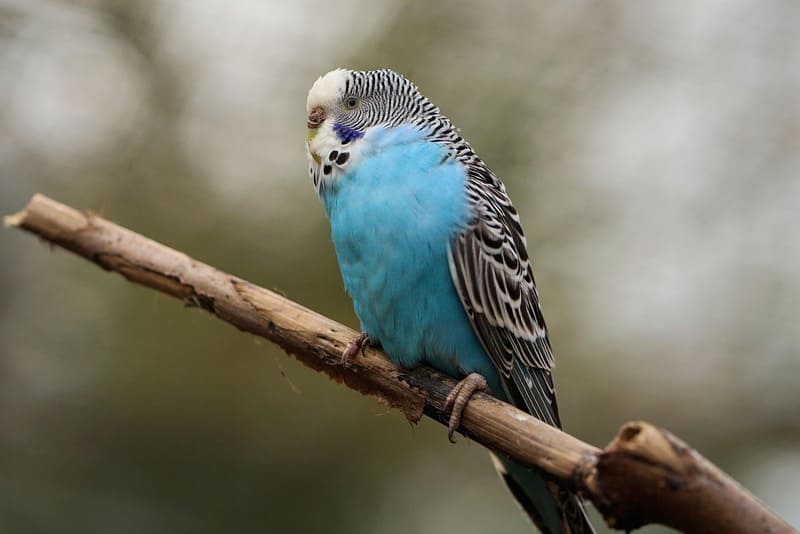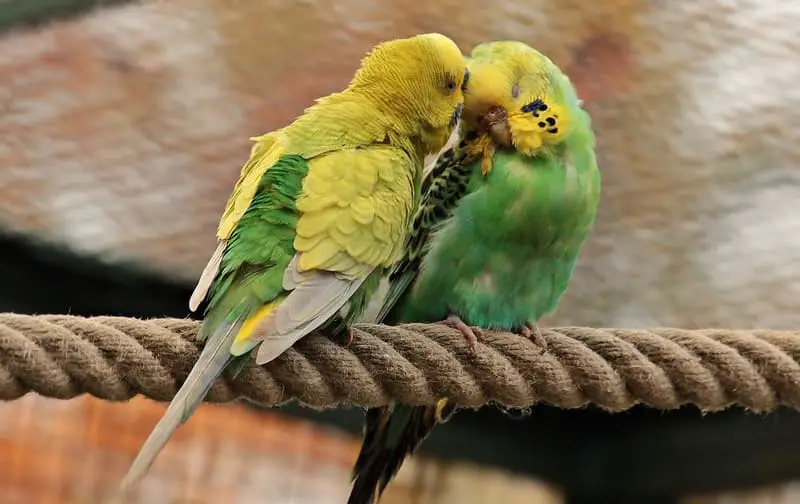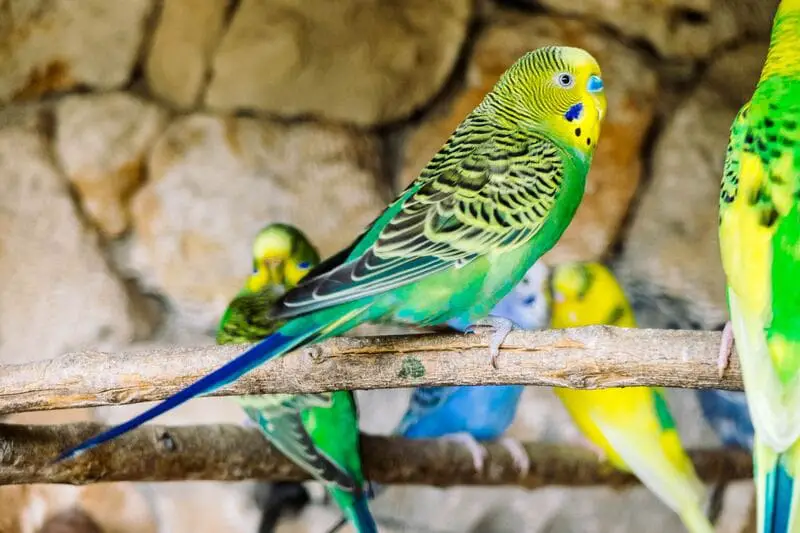Parakeets, also known as budgerigars, are delightful and popular pet birds known for their vibrant plumage, charming personalities, and playful behavior. When considering bringing a parakeet into your home, one of the decisions you’ll face is whether to get one or two of these feathered companions. This choice is an important one, as it can impact the well-being and happiness of your parakeet(s). In this comprehensive article, we will explore the factors to consider when deciding whether to get one or two parakeets, the benefits and drawbacks of both options, and how to provide the best care for your avian friend(s).

The Social Nature of Parakeets
Parakeets are highly social birds in the wild. They are native to Australia and are often found in flocks, where they engage in various social interactions, including grooming, playing, and vocalizing. This natural behavior reflects the social nature of parakeets and their need for companionship.
In the wild, parakeets form strong bonds with other parakeets and rely on the presence of their flock for safety and emotional support. When kept as pets, parakeets often transfer their social needs to their human caregivers and, sometimes, to other parakeets.
Benefits of Getting One Parakeet
There are several advantages to having just one parakeet as a pet:
1. Strong Bond with the Owner
A single parakeet can form a particularly strong bond with its human owner. The bird may become more reliant on human interaction and companionship, leading to a deep and rewarding relationship between the bird and its owner.
2. Easier Training
Training a single parakeet is often more straightforward than training two birds. With one bird, you can focus your attention on teaching and socializing with it, which can lead to quicker progress in training.
3. Less Noise and Mess
A single parakeet may be quieter and produce less mess compared to having two or more birds. With fewer birds, the level of noise and the amount of feathers, dander, and debris in the cage are generally reduced.
4. Lower Initial Costs
Acquiring and caring for one parakeet typically incurs lower initial costs than getting multiple birds. The expenses associated with housing, food, and accessories are more manageable with a single bird.
5. Individual Attention
A solitary parakeet can receive more individual attention from its owner. This can lead to a stronger and more personalized connection with the bird.
Drawbacks of Having One Parakeet
While there are benefits to having one parakeet, there are also potential drawbacks:
1. Loneliness
Parakeets are social birds by nature, and a solitary parakeet may experience loneliness and stress without a companion. Loneliness can lead to behavioral issues and a decrease in the bird’s overall well-being.
2. Boredom
A single parakeet may become bored without the interaction and stimulation provided by another bird. Boredom can result in negative behaviors such as excessive vocalization or feather plucking.
3. Emotional Dependence
A parakeet that forms an extremely strong bond with its owner may become emotionally dependent. This can lead to stress and anxiety when the owner is not present.
4. Limited Socialization
A single parakeet may not have the opportunity to engage in social interactions with another bird, which is essential for their mental and emotional health.
5. Behavioral Issues
Loneliness and boredom can contribute to behavioral problems, such as excessive screaming, feather plucking, and aggression. These issues can be challenging to address in a solitary parakeet.

Benefits of Getting Two Parakeets
Bringing two parakeets into your home offers several advantages:
1. Companionship
Parakeets are social birds that thrive on companionship. When you have two parakeets, they can provide each other with constant companionship, reducing feelings of loneliness and stress.
2. Social Interaction
Two parakeets can engage in natural social behaviors, such as grooming, playing, and preening. These interactions contribute to their mental and emotional well-being.
3. Mental Stimulation
With another bird around, parakeets have more opportunities for mental stimulation, reducing the risk of boredom and related behavioral issues.
4. Emotional Support
Parakeets can offer each other emotional support in stressful situations. They can be a source of comfort during times of change or when the owner is not present.
5. Reduced Emotional Dependence
When parakeets have each other for companionship, they are less likely to become overly emotionally dependent on their human owner. This can help prevent stress when the owner is away.
Drawbacks of Having Two Parakeets
While having two parakeets has its benefits, there are also some potential drawbacks:
1. Potential for Bonding Challenges
In some cases, a pair of parakeets may bond closely with each other and be less inclined to interact with their human owner. This can make it more challenging to establish a strong bond between the owner and the birds.
2. Increased Noise
Two parakeets may be noisier than one, as they can engage in vocal interactions with each other, which may include chatter, squawking, or vocalizing their bond. This can be bothersome if you live in close quarters with neighbors.
3. Quarantine Requirements
If you plan to introduce a second parakeet to your home, it’s important to follow proper quarantine procedures to ensure the health of both birds. This may involve temporarily housing the new bird separately and seeking guidance from an avian veterinarian.
4. Space and Housing
Having two parakeets necessitates a larger cage and more space than keeping a single bird. Proper cage size is essential to accommodate their need for exercise and comfort.
The Decision-Making Process
The decision of whether to get one or two parakeets is a significant one, and it should be made with careful consideration. Here are some factors to guide your decision:
1. Your Time and Availability
Consider your daily schedule and how much time you can dedicate to your parakeet(s). If you have more time to interact with and socialize your bird, a single parakeet may thrive with your attention. If your schedule is busier, two parakeets can provide each other with companionship when you’re not available.
2. Your Experience and Training
If you are an experienced bird owner and have the skills to provide proper training and socialization, you may be able to develop a strong bond with a single parakeet. If you’re new to bird ownership, having two parakeets can provide them with essential companionship and minimize feelings of loneliness.
3. Housing and Space
Consider the size of your living space and the type of housing you can provide. Parakeets require a spacious cage with ample room for exercise and play. If you have the space for a larger cage, accommodating two parakeets may be more manageable.
4. Budget and Costs
Evaluate your budget for pet care. The expenses associated with owning one parakeet are generally lower than those for two birds. Assess your financial capacity to provide for their needs, including food, toys, and healthcare.
5. Your Goals and Expectations
Consider your goals and expectations for your relationship with your parakeet(s). If you’re seeking a particularly strong and exclusive bond, having one parakeet may be more suitable. If you prioritize social interaction and the natural behaviors of parakeets, two birds can offer each other companionship and mental stimulation.
6. The Bird’s Personality
If you already have one parakeet and are contemplating getting another, observe the personality of your current bird. Some parakeets are more solitary by nature and may not be open to bonding with a new companion. Others may be social and enjoy the presence of another bird.
7. Consult an Avian Expert
Before making a decision, it’s advisable to consult with an avian veterinarian or an experienced bird behaviorist. They can provide guidance based on your specific situation, the bird’s behavior, and your goals as a pet owner.

How to Introduce Two Parakeets
If you decide to get two parakeets, it’s important to introduce them to each other properly to minimize stress and ensure a harmonious relationship. Here are steps to follow when introducing two parakeets:
1. Quarantine the New Bird
When bringing a new parakeet into your home, keep it in a separate cage for quarantine. This is crucial to prevent the potential spread of diseases and to observe the new bird’s health.
2. Choose the Right Time
Wait until both parakeets are in good health and have completed the quarantine period before introducing them. Choose a time when you can closely monitor their interactions, preferably over a weekend or when you have free time.
3. Use Neutral Territory
Introduce the birds in a neutral territory that neither bird has claimed as its own. This can help prevent territorial disputes.
4. Supervise the Introduction
Keep a close eye on the birds during the initial introduction. Expect some initial curiosity and cautious interactions, which can include posturing, chirping, and mild vocalizations.
5. Observe Their Behavior
Pay attention to the body language and vocalizations of the parakeets. Look for signs of aggression, stress, or overly dominant behavior. If any of these behaviors escalate, be prepared to separate the birds.
6. Provide Separate Food and Water
Initially, offer separate food and water dishes to ensure both birds have access to essential resources without competition.
7. Gradual Integration
Over several days or weeks, gradually integrate the birds by allowing them to share the same space for longer periods. Monitor their interactions and look for signs of acceptance and bonding.
8. Separate Cages
Keep separate cages available until you are confident that the parakeets have formed a positive bond and can coexist peacefully. Some parakeets may never share a cage, while others may bond closely and share their living space.
Conclusion
The decision of whether to get one or two parakeets is a significant one, and it should be based on careful consideration of your own circumstances and the well-being of your feathered companions. Parakeets are social birds that can benefit from the companionship of another bird, reducing feelings of loneliness and providing mental stimulation. However, they can also form strong bonds with their human owners when kept as single pets.
The choice of one or two parakeets should align with your ability to provide the necessary time, attention, and resources for their well-being. Regardless of your decision, prioritize their physical and emotional health by offering a suitable cage, a balanced diet, regular interaction, and mental stimulation. Additionally, consult with avian experts for guidance and advice to ensure that your parakeet(s) enjoy a fulfilling and happy life in your care.
